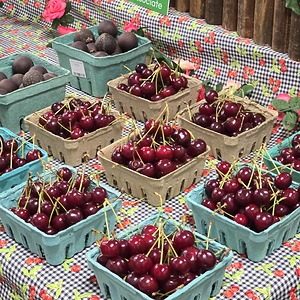


Belle Magnifique Cherries
Estimated Inventory, lb : 0
Description/Taste
Belle Magnifique is a sour cherry variety that measures about 2 centimeters in diameter. They have a squashed round shape, slightly wider than they are tall. There is a slight depression where the cherry meets its slender, green stem, which measures about 3 centimeters in height. Belle Magnifique cherries feature ruby-red skin with patches of slightly darker tones and a smooth, shiny texture. The cherry's succulent, semi-translucent flesh has a blood-orange hue and releases a colorless juice. This flesh encases an oval, cream-colored pit. Belle Magnifique cherries have a fresh, fruity, and sweet aroma with subtle floral notes. Biting into the meaty yet tender flesh of the cherry reveals a tart and sweet taste, accented by mildly acidic notes.
Seasons/Availability
Belle Magnifique cherries are harvested mid-summer.
Current Facts
Belle Magnifique cherries are botanically classified as Prunus cerasus and belong to the Rosaceae family, which includes other stone fruits like apricots, nectarines, peaches, and plums. The other botanical name for cherries is Prunus avium, which refers to the sweet cherries that tend to be eaten on their own rather than varieties like Belle Magnifique, which are often used for making desserts and fruit preserves. Belle Magnifique is a Duke cherry, meaning that it's a hybrid of sweet and sour cherries. Though the late-ripening tree they grow on produces large yields, these cherries mature at different times. This prevents them from being harvested quickly, and as a result, has caused them to be overlooked as a mainstream, commercial variety.
Nutritional Value
While the specific nutritional value of Belle Magnifique cherries is relatively unknown, cherries as a species are generally high in vitamin C, a nutrient essential for immune and skin health. They are high in fiber and potassium, which is important for digestion, muscle contraction, nerve function, and blood pressure. Cherries contain anti-inflammatory compounds like polyphenols, a healthy chemical that may help fight cellular damage and potentially protect against heart disease, diabetes, and mental decline. These anti-inflammatory properties can also help alleviate exercise-induced muscle pain and reduce symptoms of arthritis and gout. Cherries contain a significant amount of melatonin, a substance that may improve sleep quality and duration.
Applications
Belle Magnifique cherries have a sweet, tart flavor that can be eaten fresh out of hand. They are often cooked into chutney or jams, tossed into salads, chopped into salsa, or used as a marinade for ribs. In addition to savory dishes, Belle Magnifique cherries can be used in desserts such as pudding, cakes, tarts, pies, and ice cream. Belle Magnifique cherries pair well with blueberries, peaches, watermelon, microgreens, cucumbers, meats such as beef, poultry, and pork, feta cheese, and peanuts. The fruits will keep for up to a week when stored in a plastic bag in the refrigerator.
Ethnic/Cultural Info
Belle Magnifique cherries were first introduced in 1795 by a nurseryman named Chatenay Magnifique who lived near Paris. The cherry was initially known as "Belle de Chatenay”, though the name Belle Magnifique became more popular in America. This cherry was brought to America prior to 1830 by General H.A.S. Dearborn of Boston, Massachusetts, the President of the Massachusetts Horticultural Society. In 1852, Belle Magnifique cherries were inducted into the American Pomological Society. Cherries as a species have existed in Europe since 4,000 BC and have been growing commercially in France since the Middle Ages. In the 1500s, Jean Morelot of Fontenay le Château brought cherries back from his travels in Asia, though it was Louis XV who is credited with popularizing the fruit in France. In 1555, Nostradamus of Provence, France published his secrets for preserving cherries. By the 1600s, candying cherries became a popular practice in France.
Geography/History
Belle Magnifique cherries are native to France, having originated sometime around 1795. They grow best in temperate climates with moist, light soils and lots of sun exposure. As a hybrid breed, Belle Magnifique cherries are not found in the wild and are instead grown by small farms and home gardeners. Belle Magnifique cherries rose in popularity when they were introduced to the United States in the mid-1800s. Though they were once a prevalent variety, they have been largely forgotten due to their uneven ripening process. Today, Belle Magnifique cherries are a rare find at farmers markets and specialty grocers within the United States and Europe. Cherry connoisseurs who are patient enough to manage their sporadic ripening process may choose to grow them in small gardens.









